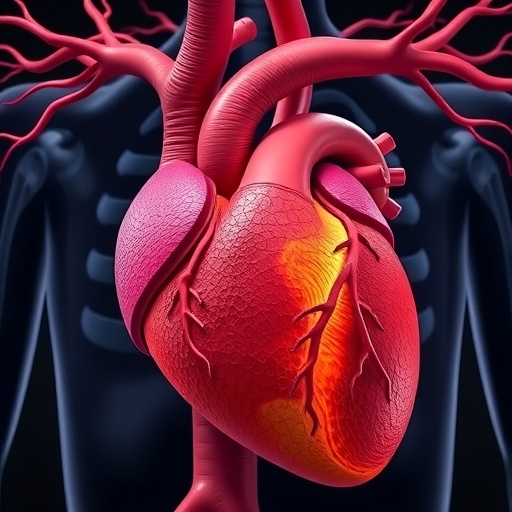Headline: A New Insight into Abdominal Endograft Collapse Induced by Acute Type A Aortic Dissection
Recent advancements in medical technology have continuously reshaped our understanding of complex conditions affecting the cardiovascular system. One such condition that is gaining attention is acute type A aortic dissection, which can have cascading effects on various medical interventions, including the integrity of abdominal endografts. The paper authored by Nakamura et al. sheds light on a critical aspect of this phenomenon, exploring how acute type A aortic dissection can lead to the unexpected collapse of these grafts, highlighting both the risks involved and the necessary precautions for healthcare professionals.
Aortic dissection remains one of the most life-threatening conditions in urgent cardiology, characterized by the tearing of the aortic wall. This pathological process initiates an intricate cascade that can quickly destabilize a patient’s hemodynamics and can lead to catastrophic outcomes. Understanding the mechanisms behind these dissections is crucial for early diagnosis and effective treatment. The article elucidates the pathways through which acute aortic dissection compromises abdominal endografts, an essential consideration for surgeons and clinicians when deciding on the appropriate course of intervention.
The study begins by establishing the baseline understandings of aortic dissection. The aorta, as the body’s primary arterial vessel, plays a pivotal role in the distribution of oxygenated blood. Acute type A aortic dissection originates in the ascending aorta and can propagate rapidly. This serves as a medical emergency that significantly raises the mortality risk if not addressed promptly. The rupture of the intimal layer of the aorta creates a new false lumen, which can disguise true hemodynamic stability and require immediate intervention.
Nakamura and colleagues proceed to discuss the implications of aortic dissection on various surgical interventions. The focus turns to abdominal endografting, a common procedure that helps repair aneurysms and other weaknesses in the aorta by inserting a graft. However, the authors reveal a concerning interaction between acute aortic dissection and these grafts, which can lead to their failure. The introduction of a false lumen can increase pressure on the graft, destabilizing it and leading to potential collapse.
An interesting aspect of their findings is the factors contributing to graft collapse. The team assesses hemodynamic changes associated with dissection, emphasizing that the alteration in blood flow can induce a mechanical failure of the graft. With increased pressure from the false lumen against the graft, the structural integrity of the device can be compromised, leading to life-threatening events. This comprehensive analysis underlines the necessity for a deeper understanding of the biomechanics involved in graft failure.
Clinicians often rely on imaging techniques for diagnosis and post-procedural assessment. The researchers stressed the importance of these diagnostic tools in monitoring patients after endograft placement. Regular imaging follow-ups are vital to assess the integrity of the graft amidst the potential complications arising from aortic dissection. The need for advanced imaging techniques that can monitor dynamic changes in real time is evident, as it may significantly influence management strategies in such high-risk scenarios.
As the research progresses, the authors turn their attention to preventative measures. Based on their findings, it is crucial to develop guidelines that help predict complications related to endograft procedures in patients predisposed to aortic dissections. While surgical innovation is pivotal, it should be complemented with strategic planning that includes a thorough understanding of patient histories, anatomical considerations, and potential surgical outcomes.
Education plays a pivotal role in disseminating this knowledge to healthcare professionals. The team advocates for specialized training modules focusing on complications arising from aortic dissection and associated interventions. Continuous education in this field can empower surgeons to make informed decisions and exercise caution during repairs, thus improving patient outcomes.
Looking forward, the research team emphasizes the need for further studies to explore new materials and designs for endografts that could withstand higher pressures from false lumens. The evolution of grafts designed explicitly for these pathological conditions could bolster surgical success and patient safety. Innovations in biocompatible materials, for instance, may provide resilience against the mechanical forces encountered during dissections, drastically reducing the risk of future complications.
Overall, the findings presented in this paper are illuminating and serve as a framework for improved surgical practices in the field of cardiovascular surgery. The intricate dynamics involved in aortic dissection and endograft stability represent an ongoing area of research ripe for exploration. The insights provided could potentially redefine standards of care in managing patients with acute type A aortic dissection.
The study’s significance underscores the need for a multidisciplinary approach to tackling these challenges. Collaboration between cardiologists, radiologists, and surgeons will be paramount in developing comprehensive management systems for patients suffering from aortic dissections, ultimately aiming to reduce morbidity and mortality associated with such devastating events.
As we delve deeper into the complexities of cardiovascular health, studies like this remind us of the profound interplay between structure and function—between the life-saving technologies we deploy and the very nature of the diseases we seek to combat. The examination of endograft collapse due to conditions like aortic dissection represents just one facet of a larger puzzle in cardiovascular medicine, demanding attention and continuous innovation.
In conclusion, Nakamura et al.’s study serves as a crucial call to action for the medical community. By unearthing the connections between acute type A aortic dissection and endograft collapse, we gain not only knowledge but also the imperative to translate this information into practice. The stakes are high, as lives hang in the balance, demanding that we remain vigilant, informed, and committed to advancing our understanding of this critical intersection in cardiovascular health.
Subject of Research: Acute Type A Aortic Dissection and its Impact on Abdominal Endografts
Article Title: Abdominal endograft collapse due to acute type A aortic dissection.
Article References: Nakamura, S., Kudo, T., Yokota, J. et al. Abdominal endograft collapse due to acute type A aortic dissection. J Artif Organs 29, 1 (2026). https://doi.org/10.1007/s10047-025-01533-8
Image Credits: AI Generated
DOI: https://doi.org/10.1007/s10047-025-01533-8
Keywords: Acute Type A Aortic Dissection, Abdominal Endograft, Hemodynamics, Surgical Innovation, Patient Safety, Cardiovascular Surgery, Diagnostic Imaging, Complications Management, Preventative Measures, Multidisciplinary Collaboration.
Tags: abdominal endograft collapseacute aortic dissectioncardiovascular complicationshealthcare precautions for surgeonshemodynamic instabilitymechanisms of aortic dissectionmedical technology advancementsNakamura et al. study findingspatient outcomes in aortic dissectionrisks of endograft failuresurgical considerations for aortic dissectionurgent cardiology interventions





